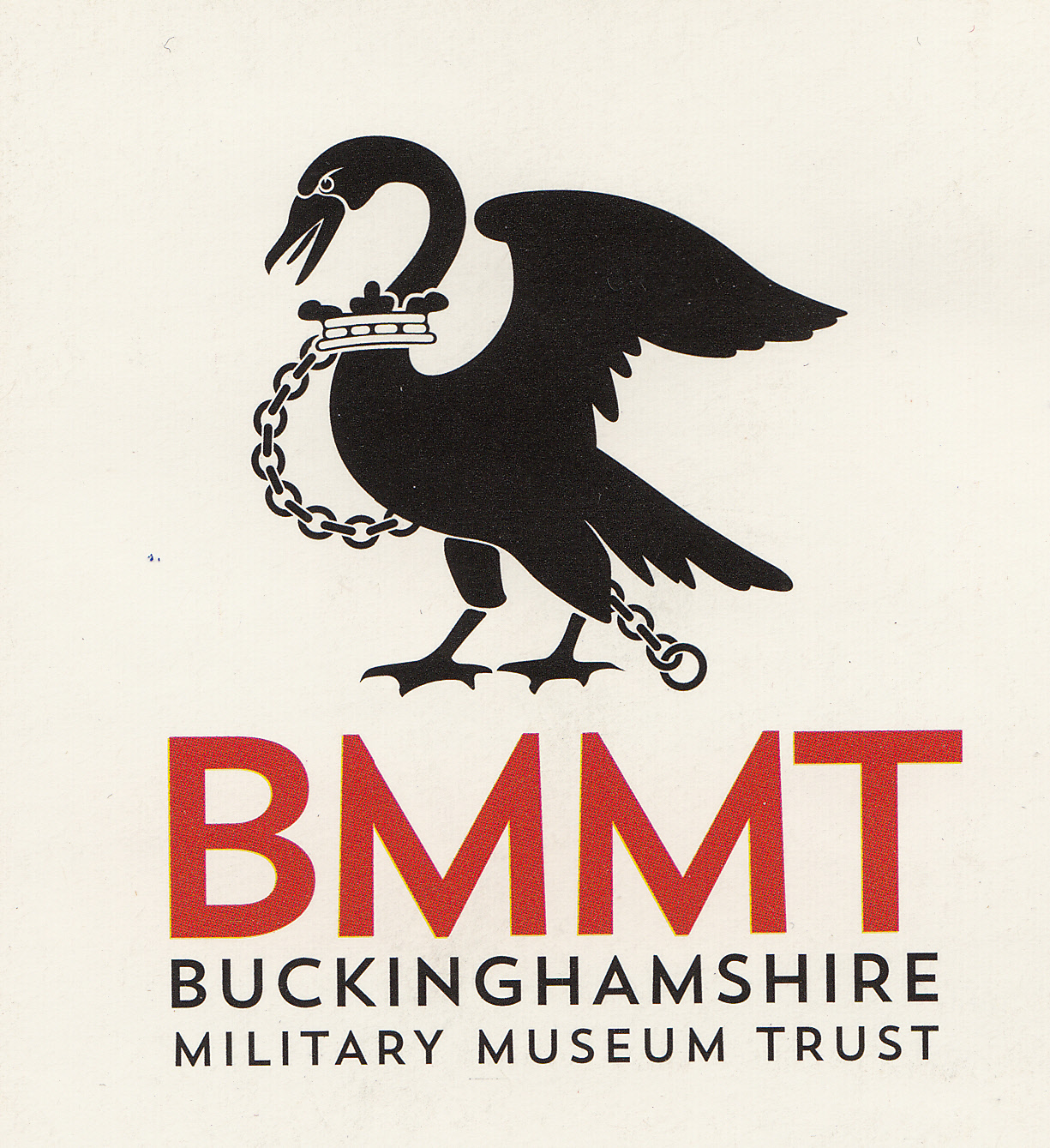Bucks Military Museum Trust – At War’s End
High Wycombe Museum
13 May to 16 November 2025
An exhibition to commemorate the 80th anniversaries of VE and VJ Day.
Remembering not just the end of two world wars but also how those from the county who served in all overseas conflicts.
Tuesdays, Fridays and Saturdays, 1000-1600
Priory Avenue, High Wycombe, HP13 6PX
The prosthetic hand of Corporal George Adkins MM, the son of the schoolmaster from Stokenchurch, who was wounded on 16 July 1916 whilst serving with the 1/4th Oxfordshire and Buckinghamshire Light Infantry, Made at Queen Mary’s Convalescent Auxiliary Hospital – known as the Human Repair Factory – at Roehampton
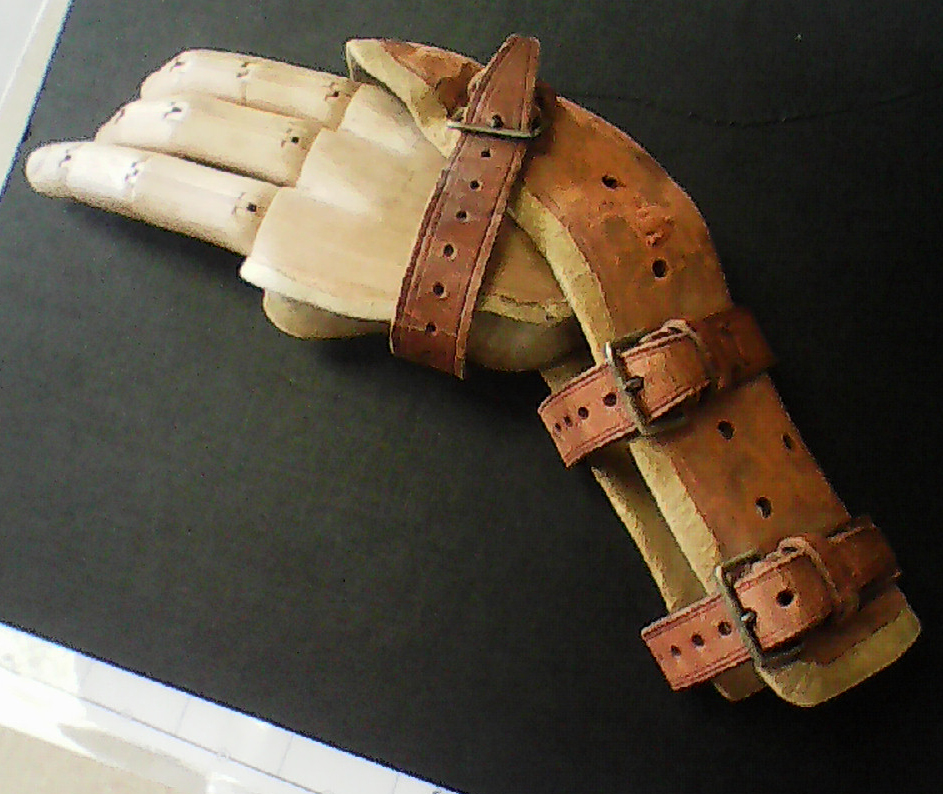
Chiltern Village Walk
11 May 2025
A walk through Lane End with focus on the role of the village in the 1913 military manoeuvres, the wartime service of villagers in the First World War and the impact of German bombs and V-weapons in the Second World War.
Meet 10.30 a.m. at the Finings Road Car Park, HP14 3ER.
Information and booking through Simon Cains at simon.cains@gmail,.com
Help Marina Get Back To Her Best
We are raising funds to pay for the restoration of our portrait of Princess Marina, the Duchess of Kent (below), an Honorary Colonel of the Buckinghamshire Battalions and their successors.
The work was painted in 1939 by William Acton, a relatively well-known portrait artist of the 1930s, who served in the Pioneer Corps during the Second World War. The painting was presented to the Bucks Battalion after his death in 1945, and hung in the TA Drill Hall in Aylesbury for many years. It was later loaned to the former Bucks County Council and was, until recently, displayed in the old County Hall in Aylesbury.
Princess Marina was the wife of Prince George, Duke of Kent, and a first cousin to Prince Philip, the Duke of Edinburgh. She became the Honorary Colonel of the First Bucks Battalion in 1938 and held then the Second Battalion soon after the outbreak of war, a position she held jointly with Lord Cottesloe. In 1947, when the Territorial Army was reconstituted in the aftermath of the Second World War, 645 (Bucks) Light Anti-Aircraft Regiment replaced the Bucks Battalions, and Princess Marina and Lord Cottesloe remained Joint Honorary Colonels, the latter until his death in 1953, when he was replaced by Colonel R. N. Guest, formerly Honorary Colonel of 480 HAA which had merged with 645 to form 431 LAA. Princess Marina retained her Colonelcy until her death in August, 1968.
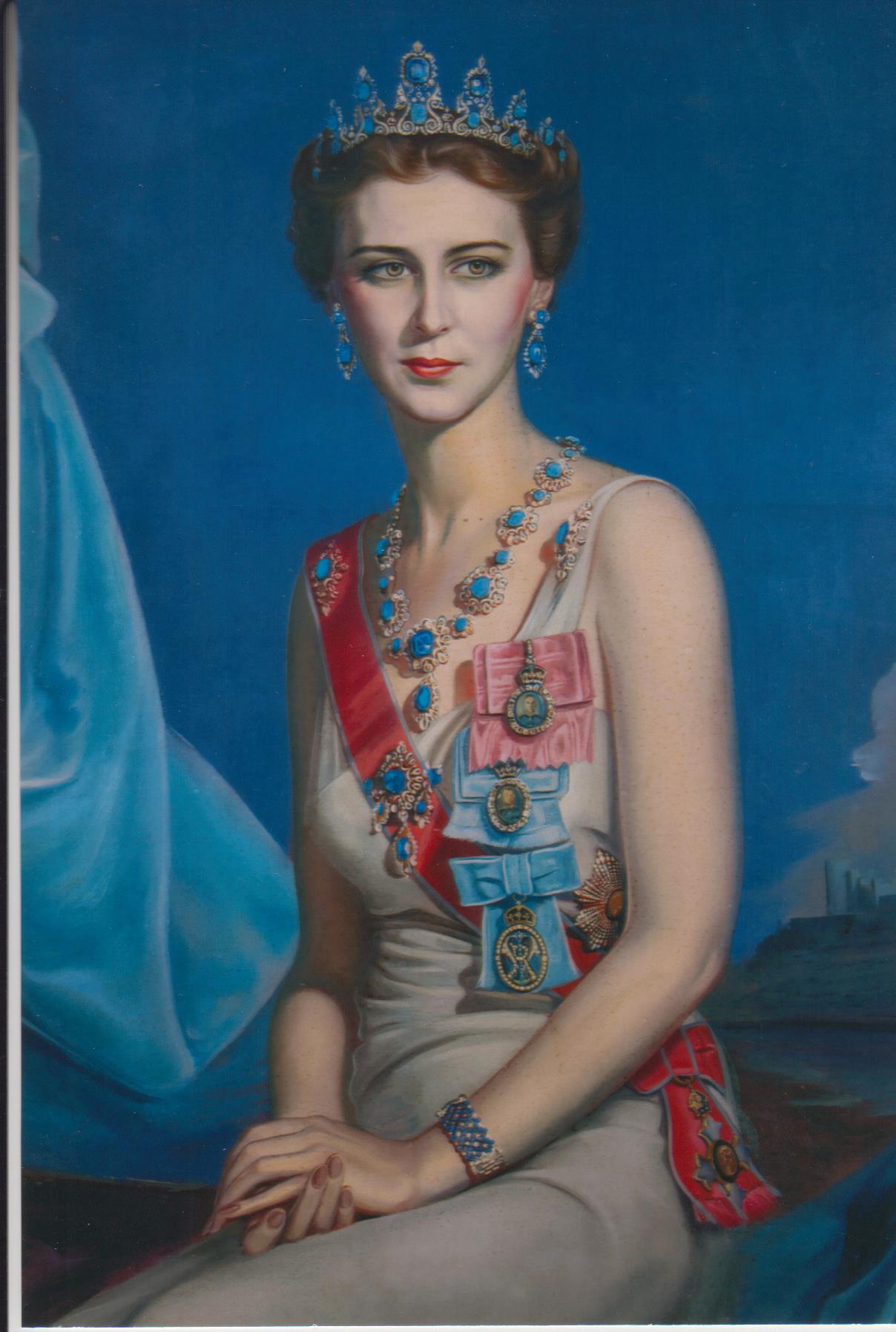
Remembering Bucks Heroes of WW1
Saturday 12 November 2022 10am – 4pm
As part of Buckinghamshire Archives History Month learn about some of Buckinghamshire’s Great War Heroes as we approach Remembrance Sunday.
A Remembrance event unveiling the hidden stories of war heroes through displays and objects linked to WWI soldiers.
There will be opportunities to see objects from our collections not usually on display and exhibition boards telling stories of real Buckinghamshire soldiers. Visitors can add to a paper poppy display started by families and schools, as a collaborative display of remembrance and gratitude. There will be a free talk: ‘Bucks in the Great War’ by Ian Beckett from the Bucks Military Museum Trust (Times: 11am and repeated at 2pm)
Free talk: ‘Bucks in the Great War’ by Ian Beckett from the Bucks Military Museum Trust (Times: 11am and repeated at 2pm)
Please book your free ticket to attend one of our talks, due to limited availability. Talks will last around an hour
Tickets from https://discoverbucksmuseum.digitickets.co.uk/event-tickets
This event is part of Buckinghamshire History Festival 2022, hosted by Buckinghamshire Archives.
Forthcoming Talk
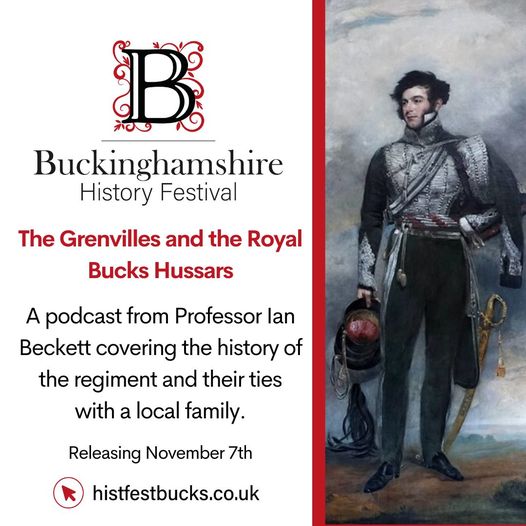
The Oxfordshire and Buckinghamshire Light Infantry, 1741-1966
The military historian, Sir Arthur Bryant, wrote of the Regiment:
‘An immaculate record in adherence to its simple creed and morality as that of the old 43rd and 52nd: North America, the Peninsular War, the field of Waterloo, the Delhi Gate, the deck of the Birkenhead.’
And when they have endured and overcome and conquered, they have left in the many lands they have visited as liberators or conquerors, memories of their gentleness, good discipline and considerate feeling. What Ambassador or Missionary has ever done more’
ORDER: Volume 1 and 2 (only sold as a set of two): ISBN 978-1-7396524-2-5)
Cost £50.00 + £10.00 postage and packing: Total: 60.00
Either by post or collected from Edward Brooks Barracks by arrangement:
Payment: By Bank Transfer or Cheque:-
By Transfer to: Oxfordshire and Buckinghamshire Light Infantry Committee
Bank: Barclays Sort Code: 20-65-21 Ac No 10682543
Include your name in the Reference Box
Or By Cheque made out to:
Oxfordshire and Buckinghamshire Light Infantry Committee.
For collection – Edward Brooks Barracks, Cholswell Road, Shippon, Oxon, OX13 6HW
Contact Mr Mike Marr, 32 Ash Close, Watlington, OX49 5LW
email: marr581@aol.com To arrange collection.
The books can also be purchased from
Soldiers of Oxfordshire Museum, Park Street, Woodstock, Oxon
OX20 1SN, Tel: 01993 810210 Contact name Duncan Parsons
and
RGJ (Rifles) Museum, Peninsula Barracks, Romsey Rd, Winchester, SO23 8TS,
Tel: 01962 828549. Contact name Christine Pullen
Viney Memorial Lecture Returns After Covid Break
The Viney Memorial Lecture remembers the Trust’s founder, Aylesbury-born Major Elliott Viney, DSO, MBE, TD, DL, who briefly commanded the 1/1st Bucks Battalion at the French town of Hazebrouck, in May, 1940, helping to hold the perimeter around Dunkirk in order to buy time for over 300,000 personnel to be evacuated from the beaches.
Dr Lyman FRHistS is a Research Fellow at the Changing Character of War Centre, Pembroke College, Oxford. Following 20 years in the British army, he publishes widely on the Second World War in Europe, North Africa and Asia. He lectures for the National Army Museum and the Kohima Educational Trust, and speaks regularly at Chalke Valley History Festival. His new book about the Forgotten War is A War of Empires: Japan, India, Burma & Britain 1941-45.
Tickets for the lecture are available from the Buckingham Literary Festival booking office at: https://www.bucklitfest.org/tickets/

2022 Spring Lecture Series – “Battles with a Buckinghamshire Connection”
If you’re interested in the military history and heritage of Buckinghamshire you won’t want to miss the BMMT’s Spring Lecture series.
We’ve pulled together a stellar line-up of academics to shine a spotlight on battles with a Buckinghamshire connection.
From Agincourt to Waterloo, from Somme mud to the pine-clad limestone slopes of the Italian mountains, Bucks soldiers have left an indelible mark on the nation’s military history. During our Spring lecture series we’ll be exploring the links between Buckinghamshire and some of the most famous battles in history.
Lecture 1 – 26 April, 2022 at 1900.
The programme will kick off on Tuesday, 26th April, with a look at one of the great historical controversies of the Battle of Waterloo.
Which regiment should get the credit for inflicting defeat on Napoleon’s crack Imperial Guard as the famous battle reached its climax on 18 June, 1815? This question has been the subject of historical debate for decades. Some argue that the glory belongs to the 1st Foot Guards, later renamed the Grenadier Guards. However, for others, the daring attack into the enemy’s flank by the 52nd of Foot, the forerunners of the Oxfordshire and Buckinghamshire Light Infantry was the decisive act that forced the previously undefeated Guard to break and run. Military historian, Gareth Glover will shed new light on the controversy when he delivers the first of our Spring lectures.
A former naval officer, Gareth Glover is one of the foremost experts on Waterloo, his many publications including The Great Waterloo Controversy: The Story of the 52nd Foot at History’s Greatest Battle (2020); Waterloo in 100 Objects (2015), Waterloo: Myth and Reality (2014), Wellington’s Voice: The Candid Letters of Lieutenant Colonel John Fremantle, Coldstream Guards.
This will be a virtual lecture, via Zoom. You can register to take part here:
https://zoom.us/webinar/register/WN_Py6sTnZdRU2mAAc4HDfvmg
If you missed this lecture you can view a recording here
Lecture 2 – 10 May, 2022 at 1900.
Was the Battle of Agincourt Buckinghamshire’s first “battle honour”?
According to local folklore, a Bucks contingent took part in Henry V’s famous victory over the French on St Crispin’s Day, 1415. This is based on a stanza from Michael Drayton’s poem, “The Ballad of Agincourt”, circa 1600, in which he wrote: “The mustered men for Buckingham are gone, Under the swan, the arms of the old town.” Professor Anne Curry will consider the county’s supposed connection with the battle in the second of the BMMT’s Spring Lecture Series.
Anne Curry, Emeritus Professor of Mediaeval History at the University of Southampton is an internationally recognised expert on Agincourt and the Hundred Years War. Her many publications include Agincourt (2015), Henry V: From Playboy Prince to Warrior King (2018) and, edited with Malcolm Mercer, The Battle of Agincourt (2015). She also directed The Soldier in the Later Middle Ages research project and is a Past President of the Historical Association and Chairman of the Battlefields Trust.
This will be a virtual lecture via Zoom. You can register to take part here:
https://zoom.us/webinar/register/WN_LBHS-QzQSR6pzsZFARtl5A
If you missed this lecture you can view it on our YouTube channel here.
Lecture 3 – 14 June 2022 at 1900.
The 1/1st Buckinghamshire Battalion, a Territorial Force unit, fought as part of the 48th (South Midland) Division throughout the First World War, seeing service at the Somme, the advance to the Hindenburg Line and Passchendaele before leaving the Western Front for Italy in November, 1917. In the third of our Spring Lectures, Dr Bill Mitchinson will chart the 48th Division’s war on the plains of Flanders, the rolling chalk downland of the Somme, the rocky, pine-clad slopes above the Asiago Plateau, and the advance into Austria as the war came to an end. Dr Bill Mitchinson is a former lecturer at the Defence Studies Department of King’s College, London, based at the UK’s Defence Academy, Shrivenham. Known for his work on the Territorials in the Great War, his books include Defending Albion: Britain’s Home Army, 1908-19 (2005), England’s Last Hope: The Territorial Force, 1908-14 (2008), The Territorial Force at War, 1914-16 (2014), The 48th (South Midland) Division, 1908-19 (2017), and Of No Earthly Use: The 2nd Line Territorial Force Divisions and the Western Front, 1914-18 (2021).
This will be a virtual lecture via Zoom. You can register to take part here:
https://zoom.us/webinar/register/WN_AtBjRpbBQmmSn3KDBxVI6g
If you missed this lecture you can view it on our YouTube channel here
Dad’s Armies: The Amateur Military Tradition in Bucks
A Talk by Professor Ian Beckett
Beaconsfield Historical Society
Saturday 26 March 2022
2.30 p.m.
Fitzwilliam Centre, Beaconsfield
Moggie Stuck in Machine Gun Muzzle for 105 Years!
Felix, the cat with nine lives, has emerged from the muzzle (flash-eliminator) of a German machine gun after being trapped there for over 100 years!
The furry feline had possibly been shoved into the weapon by a British Tommy during the battle of Passchendaele in 1917, and remained hidden ever since.
Not a real moggie of course. Felix The Cat was the name given to a popular brand of nougat manufactured by Leeds-based confectioners, Rogall’s, who had a factory in the Seacroft area to the east of the city. It was the waxed wrapping paper from the sweet that was rolled up and placed in the end of the gun barrel, only discovered when the weapon was being prepared for display at a military history festival this summer.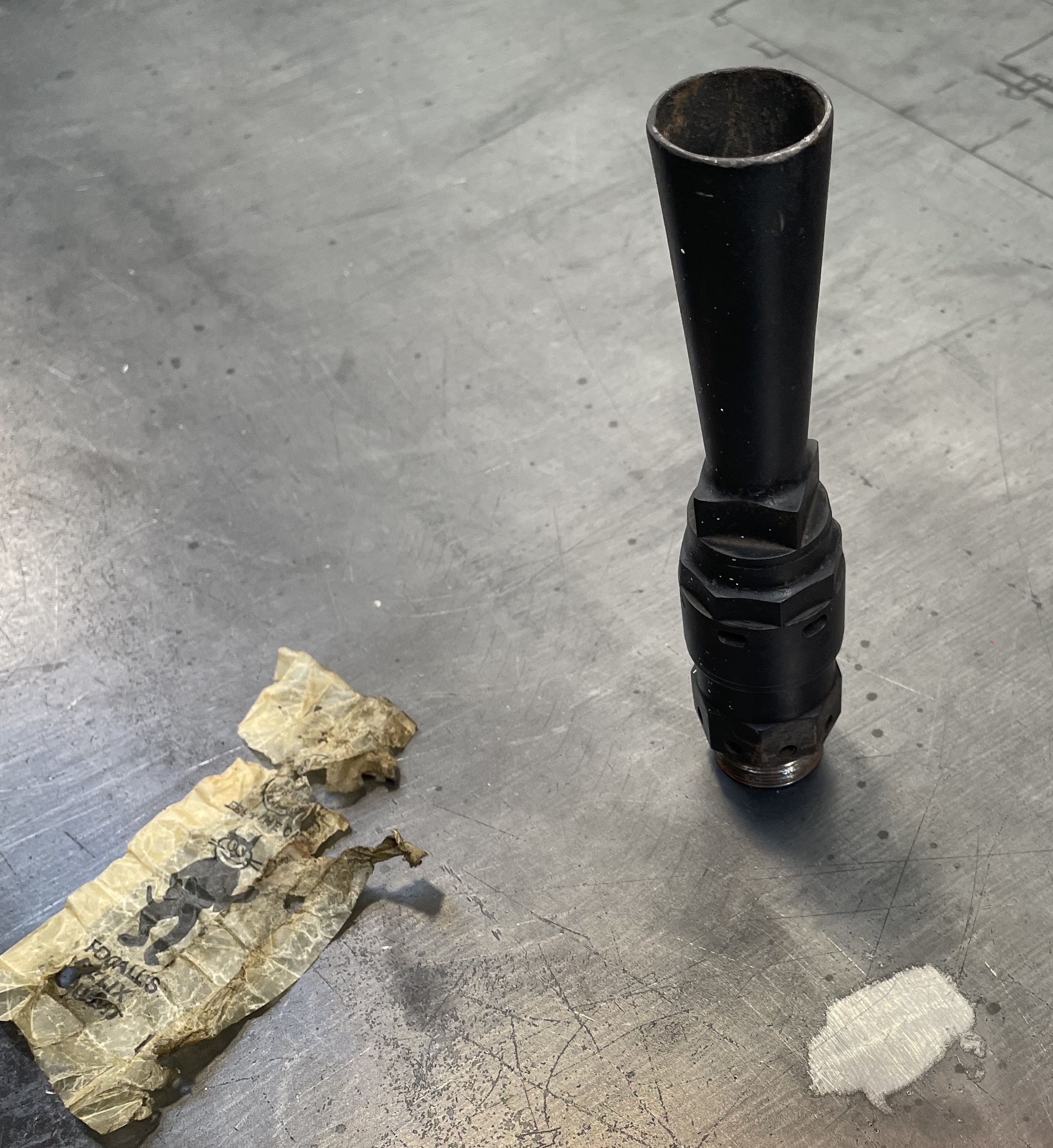
The Bucks Military Museum Trust has had the German MG08 Maxim machine gun in our collection for some time. The First World War-vintage weapon was a gift from the Royal Green Jackets Museum (now The Rifles) in Winchester in 2014 and has been in store ever since, awaiting an opportunity to be exhibited.
Having been invited to take part in a military history event this summer, we decided that this would be the perfect time to put the machine gun on show. However, the gun’s mount was missing, making it difficult to display it safely. To rectify this, we asked a local engineering company to fabricate a stand. And it was while dismantling the weapon to fit the new tripod that Felix came to light (see photographs).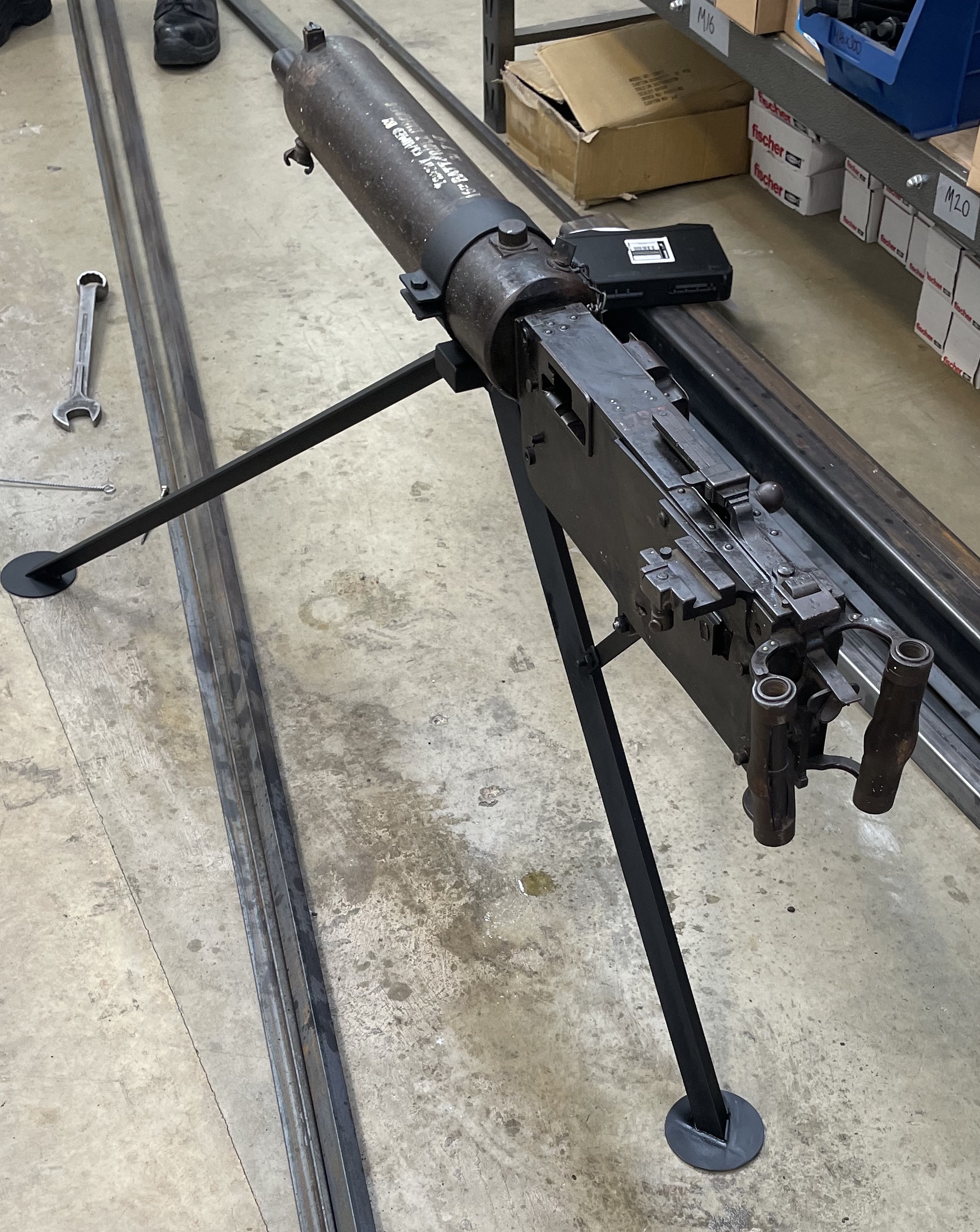
This particular MG08 was captured by troops of the 16th Battalion, the Rifle Brigade, a forerunner of the Royal Green Jackets. It still bears the scars of the fighting in which it was taken, with several bullet holes clearly visible. An inscription on the water-jacket of the gun reads: “Trophy claimed by 16th Rifle Brigade, 31 July 1917”. That date was, of course, the first day of the Battle of Passchendale, on which the battalion, part of 117th Brigade, 39th Division, XVIII Corps, took part in the 5th Army attack that would become known as the Battle of Pilkem Ridge.
The men of 16 RB were tasked to capture the German front and second line trench systems, in front of, in and behind Kitchener’s Wood, before securing crossings of the Steenbeek river, to the north of St Julien (see photograph). The battalion’s war diary contains a detailed account of the fighting, written by the Commanding Officer, Lt Col The Hon Edward Coke, MC, who was himself wounded in the assault (WO95/2586/1).
Zero was set for 0340, about 30 minutes before dawn, and was heralded by a heavy artillery bombardment on the German front line and beyond. At 0513 the battalion advanced to capture its first objective (the Black Line). Racecourse Farm offered serious opposition to the left company, where a machine gun in a concrete bunker inflicted numerous casualties until it was captured. This company then came under fire from a second machine gun at Bochcastel Estaminet, and this was silenced by rifle grenades and Lewis Gun fire. The leading waves advanced into Cannon and Canoe Trenches (Black Line) where they came under further heavy machine gun and sniper fire from Kitchener’s Wood. One machine gun in particular, apparently positioned near the ‘M’ in Bochcastel Estaminet (see map) gave a great deal of trouble until it was captured. Two officers, Lt Taylor and Lt Barrett, were among its victims.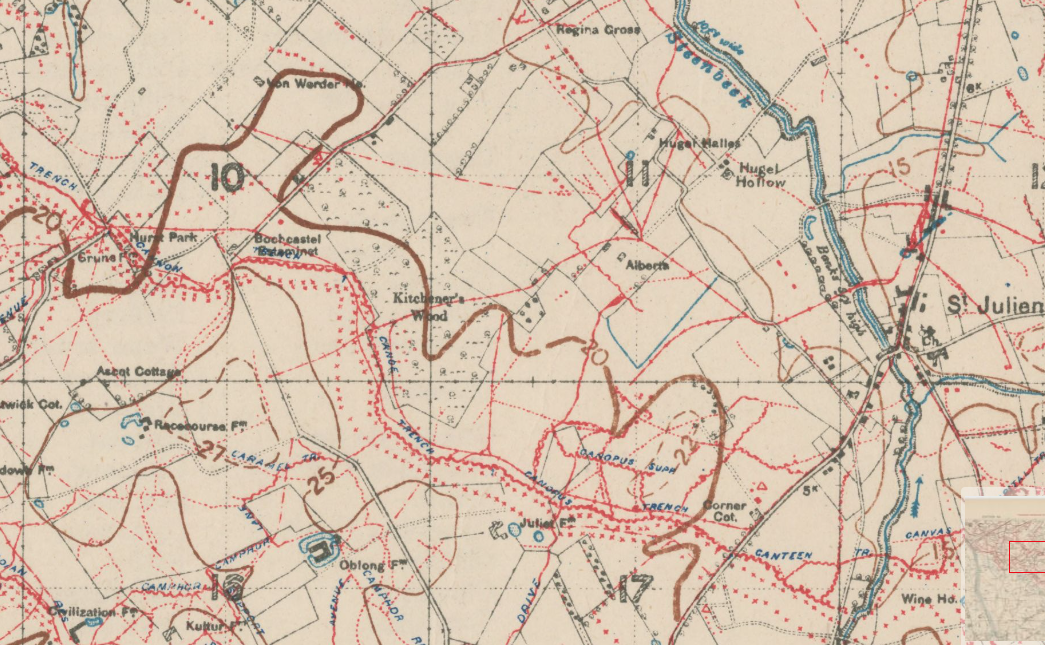
Meanwhile, the right company was fired on by two machine gun positions in Kitchener’s Wood. Both of these were captured, along with the guns and the wood was cleared before the troops advanced to the second objective (the black dotted line) where more machine guns and snipers were encountered. These groups were killed or captured and while the second objective was being consolidated, the attackers were fired on from further MGs at Regina Cross, a second position, south-west of the cross-roads, and from Alberta. The follow-on waves then passed through and headed for the Steenbeek. It was now Zero plus 1 hour 40 minutes. Regina Cross, which consisted of three strong points, offered further serious resistance on the left until platoons managed to outflank it, using Lewis Guns and Rifle Grenades, and No 27 bombs (phosphorus). About 30 Germans were killed or captured along with three further machine guns before the Steenbeek was reached and crossed. Over the six days in which the 16 RB were involved in this action their casualties were 32 killed (including two officers), 277 wounded and 18 missing. A total of seven machine guns were recovered by the battalion and taken back to the rear.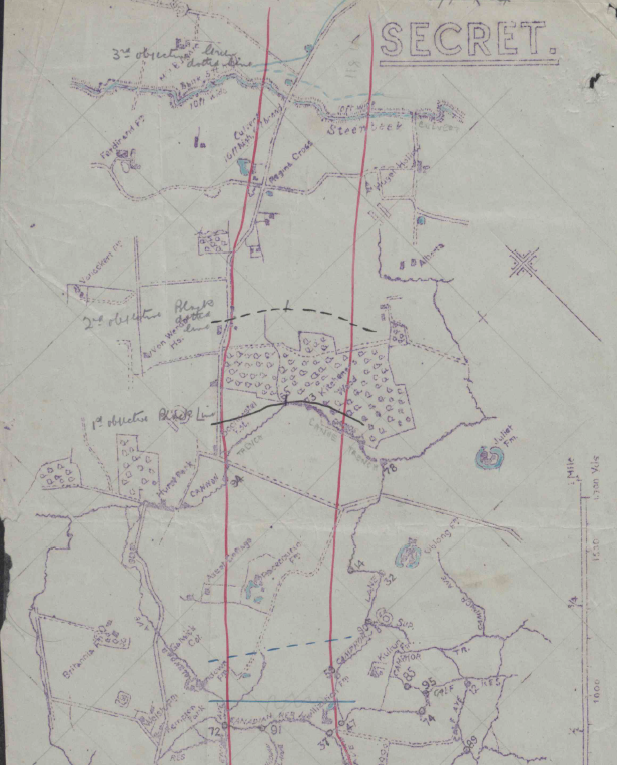
There is a direct, if tenuous Buckinghamshire link to this action. The Rifle Brigade was forced to withdraw back across the Steenbeek after a strong German counter-attack and established their line to the west of the watercourse. Two weeks later, on 16 August, the First Buckinghamshire Battalion would attack in the same area, successfully crossing the Steenbeek and securing a new line to the east.
The MG08, calibre 7.92x57mm, was the standard German heavy machine gun throughout the First World War. It was a beast, weighing in at 62.2kg (with water tank and fixed to its sled mount), but being belt-fed it had a cyclic rate of fire of 450-plus rounds per minute and an effective range of 2500 yards. A lighter version, the MG08/15, was developed during the war and could be carried and fired on the move. The MG08, although largely replaced by the lighter and more modern MG34 and MG42, was still in use by some German units in the Second World War. It was mainly used in fixed defensive positions, including along the Atlantic Wall, and was certainly encountered by allied troops in Normandy during and after the D Day landings.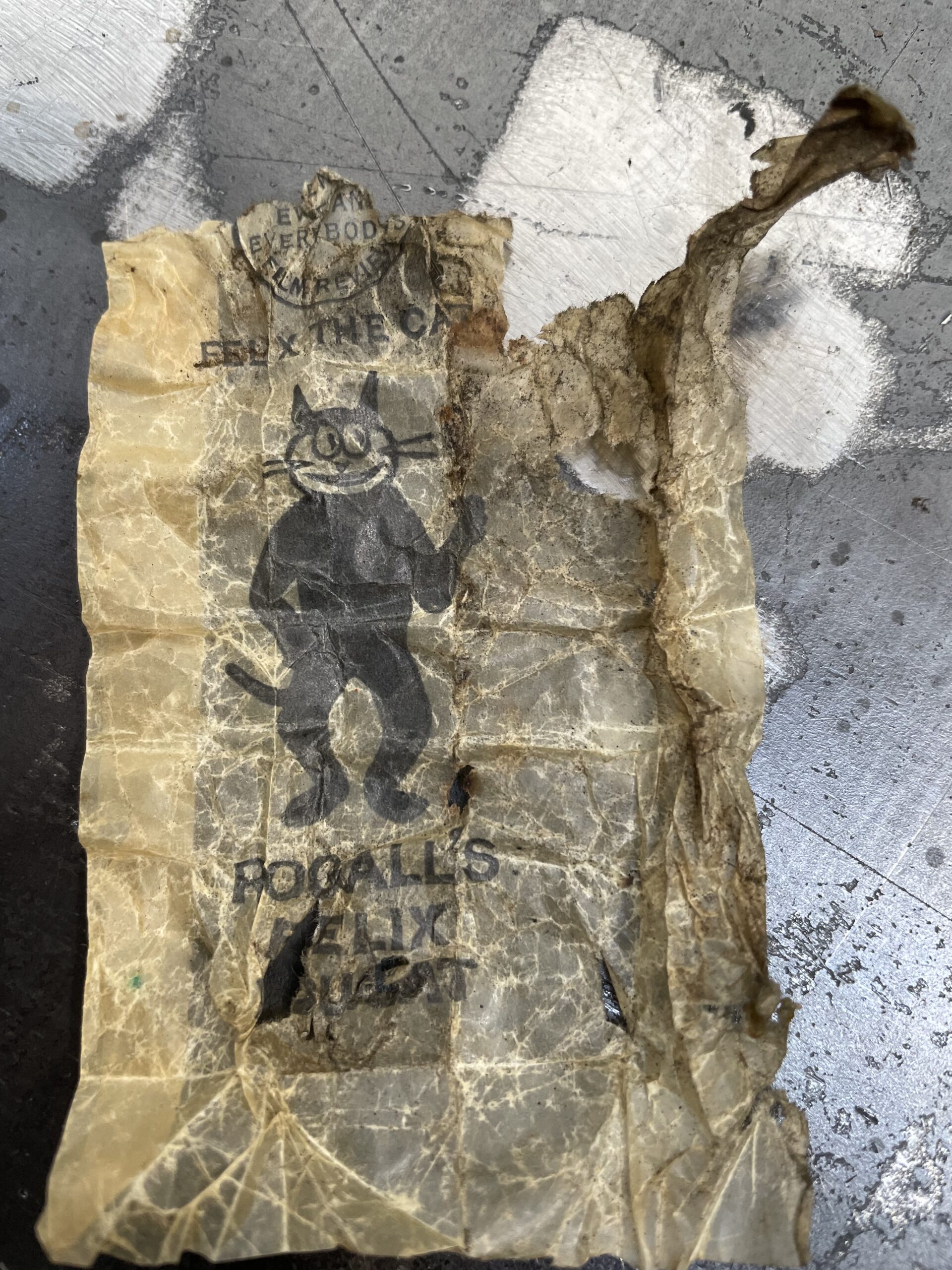
This website of The Buckinghamshire Military Museum Trust ('BMMT') is copyright of BMMT. If any items on the site are republished or copied for research private study or for use within educational establishments the source and copyright status must be acknowledged and any reference quoted. Commercial users wishing to reproduce any item must seek prior written permission from the Trustees.
BMMT has taken all reasonable steps to ascertain any known copyrights. Any infringement is inadvertent and will be rectified on notification.
